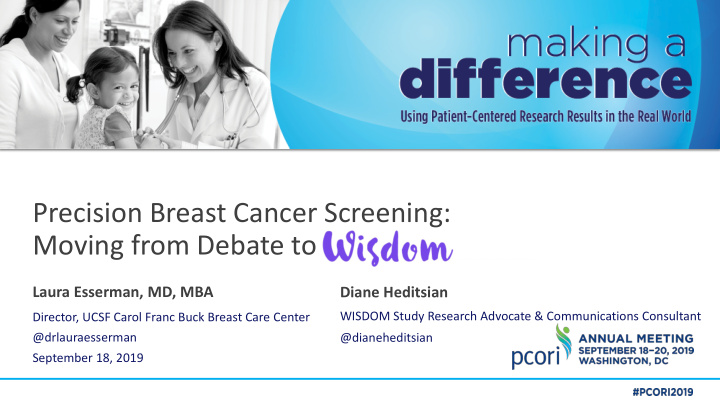



Precision Breast Cancer Screening: Moving from Debate to Wisdom _______ Laura Esserman, MD, MBA Diane Heditsian WISDOM Study Research Advocate & Communications Consultant Director, UCSF Carol Franc Buck Breast Care Center @drlauraesserman @dianeheditsian September 18, 2019
Laura Esserman • Has nothing to disclose. Diane Heditsian • Has nothing to disclose. 2
Audience Poll • How many women are getting mammography screening for breast cancer? • How many women believe there is complete agreement on when women should start and how often they should be screened? • How many women know their own breast cancer risk? 3
Years of Policy Controversy & Conflict WISDOM will provide data required to inform professional societies and resolve discordant recommendations Professional Society Screening Age Frequency USPSTF 40 – 49 Shared decision on whether to screen Biennially 50 – 74 (for average risk) ACS 45 – 55 Annually 55 – until life expectancy < 10 years. Biennially ACR / SBI 40 – until life expectancy < 5 -7 years. Annually NCCN 40 – until life expectancy < 10 years. Annually ACOG 40 – 49 Shared decision on whether to screen 50 – 74 Shared decision: Annual or Biennial ACP (new: April 2019) 40 – 49 Shared decision on whether to screen Biennially 50 – 74 4
Breast Screening Controversy Puts Women in the Middle Polarized Views Confuse MDs too 5
Old Paradigm 6
New Paradigm: Breast Cancer is not a single disease Tumor progression and Benefit (lack of) from Screening 7
Breast Cancer Screening Today • Mired in controversy • Based on 30-year-old medical science • Age-based • Low risk women are over-screened • false positive recalls and benign biopsies • High-risk women are under-screened missing lethal tumors • Catchy Public Health Messages miss the complexity • “Mammograms Save Lives” and “Early Detection Saves Lives” • Resource intensive in aggregate: $8 - $10 billion annually 8
“One Size Does NOT Fit All” 9
Unprecedented Opportunity: Advances in Science and Technology 10
What Breast Cancer Screening Could Be: Personalized • Leverages advances in: • Biology of breast cancer • Risk-assessment • Genetics • More effective at finding “clinically meaningful” cancers • Personalized and precise for each individual woman • Integrated with risk reduction strategies • More cost-effective 11
Comprehensive risk prediction model • Validated high-impact risk factors including • Exposures/Lifestyle • Breast density • 9 breast cancer genes • SNPs polygenic risk score • 76 303 SNPs • Tailor screening/prevention plans • Age to start/stop • Frequency • Screening modality • Risk reduction 12
Pragmatic Trial Design: Preference Tolerant RCT 13
Wisdom Study Aims Determine if personalized screening (as compared to annual screening): 1. Is as safe 2. Is less morbid 3. Is more accepted by women 4. Enables prevention 5. Has greater health care value 14
Risk Reduction: Breast Health Decisions Tool • Automated integration of risk education tool • Includes risk factors and interventions to lower risk • Threshold for outreach (personalized arm): Top 2.5 % risk by age group 15
Breast Health Decisions Tool 16
Transformative Trials That Evolve: WISDOM Study Structure • All reporting is automated using the WISDOM platform • Offered across several nationwide sites • California, Dakotas, Iowa, Minnesota, Illinois, Alabama, Louisiana 17
PCORI Principles • Results ready in a timely way • Used a surrogate endpoint- no increase in stage 2B cancers • Tests had to be covered by the study (payors participating) • Coverage with Evidence Progression model • Compared to annual, cost saving over time • Champion: Blue Cross Blue Shield and self-insured employers • Stakeholder Engagement • Annual stakeholder meetings to project results • All guideline makers, payors, providers at the table 18
Why is this study critical for women? • Answers a big and intractable question • Breast cancer screening can leverage precision medicine • Begin to learn who is at risk/for what kind of breast cancer • Provides a framework to determine risk, improve screening, educate/involve women and integrate risk reduction • Breaks down barriers so more women can participate • Answers will be relevant to all communities of women 19
What Does it Take For a Paradigm to Shift? What results will have enough impact to inform guidelines? What are the right early endpoints? How best to educate MDs and women? Annual Stakeholder Meeting: Full day each year 20
WISDOM Innovations • Use of established tests in new ways • Coverage with evidence development/progression • Virtual trial design • Trial comes to the participant not vice versa • Technology platform with embedded analytics • All stakeholders at the table from beginning • reduce time to implement trial results • Risk model is updated as new data emerges • Patient Reported Outcomes • Patient education and risk communication (BHD Tool) • Bioethics Committee & Embedded Ethics Study 21
Wisdom Recruitment over time 22
Lessons Learned • Opposing views will always be encountered • Radiology community in US feels that less than “annual screening” hurts women • Models will always improve • Build an infrastructure that allows study to evolve as knowledge evolves • Test the concept of personalization based on best knowledge • Allow for improvements in models • Much more difficult to get payers to partner than anticipated! • Recruiting diverse populations takes a big effort 23
Patient-Centered and Inclusive • Spanish Translation • Outreach Materials • Plain-language translation • Materials modified with simpler, 6 th grade reading level 24
Everyone Benefits When Everyone Participates 25
Thank You to Partners & Stakeholders 26
27
Thank You! Diane Heditsian Laura Esserman, MD, MBA WISDOM Study Research Advocate & Communications Consultant Director, UCSF Carol Franc Buck Breast Care Center @dianeheditsian @drlauraesserman September 18, 2019 28
Recommend
More recommend